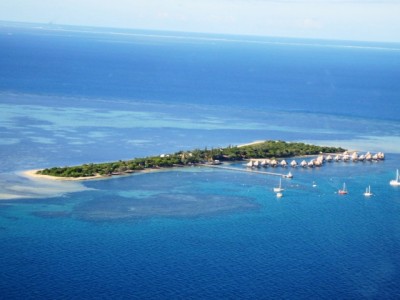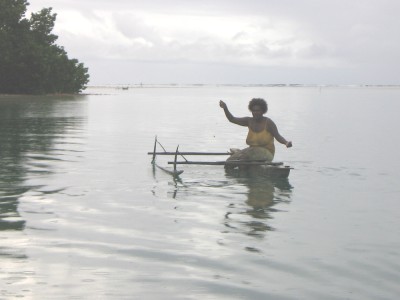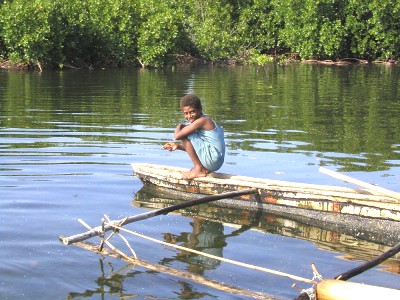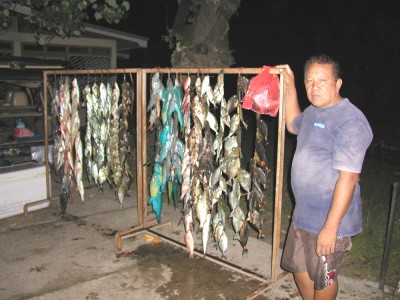by Dr. Mecki Kronen (all photos by the author)
 The South Pacific encompasses 15 independent island countries and 8 territories – in total more than 200 high islands and 2.500 low lying islands and atolls – which are distributed over a mainly tropical region with a range of 4.000 km from North to South and of 9.000 km from West to. The relationship between 550.000 km2 of land as compared to 29 million km2 of ocean, representing one third of the world’s EEZ (economic exclusive zone) highlights the island character and the diversity of the South Pacific. Moreover, the region represents 3 different, however, geographically clustered cultural zones: Melanesia, Micronesia and Polynesia.
The South Pacific encompasses 15 independent island countries and 8 territories – in total more than 200 high islands and 2.500 low lying islands and atolls – which are distributed over a mainly tropical region with a range of 4.000 km from North to South and of 9.000 km from West to. The relationship between 550.000 km2 of land as compared to 29 million km2 of ocean, representing one third of the world’s EEZ (economic exclusive zone) highlights the island character and the diversity of the South Pacific. Moreover, the region represents 3 different, however, geographically clustered cultural zones: Melanesia, Micronesia and Polynesia.
The degree of terrestrial as well as marine biodiversity is high due to the relative short distance from the Centre of Biodiversity (CoB). The coral reefs of the South Pacific are regarded as the world’s richest ecosystems in terms of biodiversity. One single coral reef may have up to 3.000 different species. Due to this potential island countries are under an enormous international pressure regarding their conservation and protection.
It is expected that the population of the South Pacific will increase from 9.8 Million (2010) to 15 Million people by 2035. This growth will be coupled with increasing urbanisation. The dependency of the South Pacific’s population from fisheries is high. This applies in terms of direct income generation, particularly in rural and isolated coastal areas, and also for food security. Hence per capita consumption of fish is very elevated. It is expected that the demographic development projected will exert significantly higher pressure on coastal fisheries resources.
 However, the potential of coastal fisheries has already been fully exploited today. Locally, many stocks are already overfished. Some have disappeared altogether without ever appearing in catch statistics focused on industrial fisheries. There is a series of factors which are at the core for the alarming situation at present. These include: Non-sustainable fishing methods, insufficient management and controls, lack of alternative income sources, habitat destruction due to infrastructure measures, sedimentation and pollution of the ocean. Climate change, in particular sea-level rise, increasing ocean acidification and the increasing sea surface temperature rise further add to the dilemma. According to current knowledge these factors will contribute to lower productivity of coastal fisheries.
However, the potential of coastal fisheries has already been fully exploited today. Locally, many stocks are already overfished. Some have disappeared altogether without ever appearing in catch statistics focused on industrial fisheries. There is a series of factors which are at the core for the alarming situation at present. These include: Non-sustainable fishing methods, insufficient management and controls, lack of alternative income sources, habitat destruction due to infrastructure measures, sedimentation and pollution of the ocean. Climate change, in particular sea-level rise, increasing ocean acidification and the increasing sea surface temperature rise further add to the dilemma. According to current knowledge these factors will contribute to lower productivity of coastal fisheries.
In addition, the South Pacific region is extremely vulnerable to climatic and weather related disasters, such as tropical cyclones, floods and spring floods and extreme rainfall events that threaten the livelihood of the coastal population and coastal ecosystems. In March 2015, when tropical cyclone PAM caused loss of several lives and destroyed the livelihoods of thousands people in the island country, the international media brought this acute threat to the attention of many people worldwide.
 Regional assessments demonstrate that artisanal sand small scale fisheries in the South Pacific are often coupled with poverty. Half of all households investigated are living below the critical benchmark of 1 US$ a day. These families are also much poorer compared with those that depend on other, non-fishery income sources, including those living in the same communities.
Regional assessments demonstrate that artisanal sand small scale fisheries in the South Pacific are often coupled with poverty. Half of all households investigated are living below the critical benchmark of 1 US$ a day. These families are also much poorer compared with those that depend on other, non-fishery income sources, including those living in the same communities.
It is evident that priority must be given to avoid further deterioration of fish stocks and thus to contribute to ascertaining the livelihood of the population that depends on fisheries. Consequently, the identification and implementation of effective management measures are imperative. Indicators that provide insight on the status of resources and that can be used to monitor impacts and success of management measures , are valuable tools for the fisheries sector.
In the framework of an EU funded regional project five fish families were identified to serve as such valuable indicators - Scaridae (parrot fish), Siganidae (rabbit fish), Acanthuridae (surgeonfish), and also, but only to a certain degree, Lethrinidae (emperor fish) und Mullidae (goat fish). They provide clues on the general state of fish resources based on relatively easy identifiable factors, for example, average catch size, proportion in total catch, and average biomass. In particular, Scaridae (parrotfish) und Siganidae (rabbit fish) suffer from high fishing pressure, which results a reduction of their relative density and biomass.
 In the South Pacific, there is a wealth of regional and national institutions, international donors, NGOs and civil society organisations, which are engaged in fisheries management, the protection and conservation of oceans and biodiversity, climate change, poverty reduction and economic development.
In the South Pacific, there is a wealth of regional and national institutions, international donors, NGOs and civil society organisations, which are engaged in fisheries management, the protection and conservation of oceans and biodiversity, climate change, poverty reduction and economic development.
In July 2014, the Leaders of the Pacific Island States ratified ‘The Framework for Pacific Regionalism’. The four following basic components are at its core: (1) economic growth, (2) sustainable development, (3) governance, and (4) security. This Framework, as well as 'The Pacific Framework for Action on Climate Change 2006-2015‘, and since 2014 the draft for a joint strategy for the Pacific development aiming at resilience to climate change and natural disasters, all share similar objectives. Focal issues include the strengthening of integrated coastal management (ICZ). ICZ is a multi-disciplinary concept for cross sectorial management of the coastal zone that aims at taking into account and at aligning all user groups and reducing the often arising conflicts amongst these.
 Why is ICZ so important? The coastal zone is the South Pacific’s most important living area as it represents the central activities: agriculture, fisheries and tourism. These sectors form the basis for the living of the major part of the region’s population. The growing population on small space - particularly in Melanesia – in combination with urbanisation exercise enormous pressure on natural resources, and thus fish stocks as well. The livelihoods and the economy of the region are highly dependent on climatic factors.
Why is ICZ so important? The coastal zone is the South Pacific’s most important living area as it represents the central activities: agriculture, fisheries and tourism. These sectors form the basis for the living of the major part of the region’s population. The growing population on small space - particularly in Melanesia – in combination with urbanisation exercise enormous pressure on natural resources, and thus fish stocks as well. The livelihoods and the economy of the region are highly dependent on climatic factors.
Natural resources are already extremely stressed and very vulnerable towards current and future climate change consequences. In other words, their resilience and regeneration capacities must be clearly strengthened and increased. In addition, the South Pacific has a high vulnerability to natural disasters with devastating consequences for the people, the environment and the economy.
Additional stress is based on a cocktail of poverty and an economy that is dominated by remittances of migrants and donor dependency. The consequence is non-sustainable development processes, lack of governance, and ecosystems that suffer from overuse and destruction. Traditional regulative mechanism that have historically developed have difficulties to overcome this combination of challenges and in the sensible fusion of traditional authority structures and rules with new technologies, as well as dealing with donors and the associated, at times even massive funds provided.
 Therefore, an integrated approach that regards the coastal zone as a whole including people, environment, biodiversity and economic security and growth, provides hope for the future of coastal fisheries, its resources and habitats, and the depending fishers and fish consumer. Recognition of traditional values and experiences of these societies may help to bridge the gap between existing traditions and new expectations and behavioural patterns.
Therefore, an integrated approach that regards the coastal zone as a whole including people, environment, biodiversity and economic security and growth, provides hope for the future of coastal fisheries, its resources and habitats, and the depending fishers and fish consumer. Recognition of traditional values and experiences of these societies may help to bridge the gap between existing traditions and new expectations and behavioural patterns.
Scientific analysis that consider the real consequences of multi-facetted local small-scale fisheries and that do not only take into account international commercial catch may contribute to correct perceptions of the current status and in formulating new sustainability objectives. Given that people in the South Pacific are mainly living in isolated local communities on hundreds if not thousands of islands scattered over a huge region and often in great geographical and cultural distance from each other, illuminates the big challenge in getting the necessary messages and help for engaging these people in the transformation process for ascertaining their livelihood.








